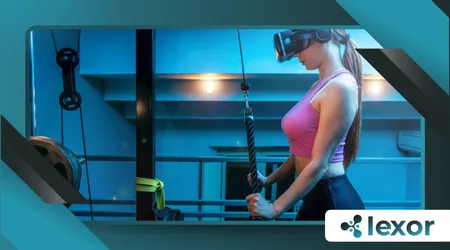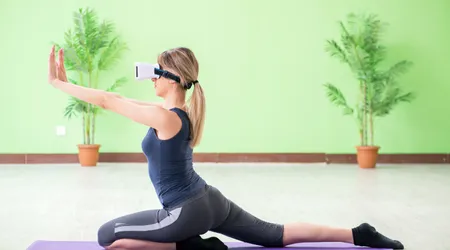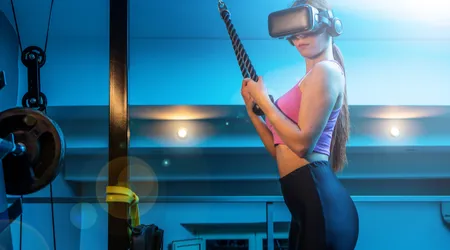VR Fitness: The Future of Home Workouts

The fitness industry is undergoing a revolutionary transformation, and at the heart of this change is VR fitness.
Combining cutting-edge virtual reality technology with physical exercise, VR fitness is redefining how we approach home workouts.
No longer confined to repetitive routines or expensive gym memberships, fitness enthusiasts are now stepping into immersive worlds where exercise feels like an adventure.
But is this just a passing trend, or is VR fitness truly the future of home workouts?
Let’s dive into the possibilities, challenges, and undeniable potential of this innovative approach to staying fit.
The Rise of Immersive Fitness Experiences
Traditional home workouts often struggle with one major issue: monotony.
Treadmills, stationary bikes, and weightlifting routines can quickly become dull, leading to a lack of motivation.
Enter VR fitness, a solution that turns exercise into an engaging, interactive experience.
By strapping on a VR headset, users can find themselves boxing in a virtual ring, climbing mountains, or even dancing in a neon-lit nightclub.
The immersive nature of VR makes workouts not only effective but also enjoyable.
Moreover, many VR fitness apps offer game modes that encourage competition, allowing users to challenge friends or other players globally.
This not only boosts motivation but also creates a sense of community, even when working out at home.
According to a 2022 report by SuperData, the VR fitness market is projected to grow by 30% annually, driven by increasing consumer interest in at-home fitness solutions.
This growth is fueled by the pandemic-induced shift toward remote workouts and the desire for more engaging fitness options.
+ VR Gaming Evolution: From Console to Full Immersion
How VR Fitness Works: A Breakdown
At its core, VR fitness leverages motion-tracking technology and immersive visuals to create a full-body workout.
Devices like the Oculus Quest 2 or HTC Vive Focus 3 use sensors to monitor your movements, translating them into in-game actions.
Whether you’re swinging a virtual tennis racket or dodging obstacles in a rhythm game, every motion counts toward your fitness goals.
The motion-tracking technology allows users to have a more realistic and responsive experience, making every movement significant.
Additionally, many VR fitness games incorporate haptic feedback, allowing users to feel resistance and interaction with the virtual environment.
Here’s a quick breakdown of how VR fitness stacks up against traditional workouts:
| Aspect | Traditional Workouts | VR Fitness |
|---|---|---|
| Engagement | Repetitive, often boring | Immersive, game-like experience |
| Accessibility | Requires equipment or gym | All-in-one headset solution |
| Calorie Burn | Varies by activity | 6-12 calories per minute (avg.) |
| Motivation | Self-driven | Built-in rewards and challenges |
As the table shows, VR fitness offers a unique blend of accessibility and engagement, making it an attractive option for those seeking variety in their routines.
The Science Behind VR Fitness
One of the most compelling arguments for VR fitness is its ability to trick your brain into enjoying exercise.
Studies have shown that immersive environments can reduce perceived exertion, meaning you’re likely to work out longer and harder without feeling the strain.
A 2021 study published in the Journal of Medical Internet Research found that participants using VR for exercise reported higher levels of enjoyment and were more likely to stick to their routines compared to traditional methods.
Moreover, research indicates that the immersive experience can increase endorphin release, resulting in a sense of well-being that is often associated with exercise.
This can help build a more positive relationship with physical activity, especially for those struggling with motivation.
Furthermore, VR fitness isn’t just about cardio.
Many apps and platforms incorporate strength training, flexibility, and even mindfulness exercises.
For example, Supernatural, a popular VR fitness app, combines high-intensity workouts with stunning landscapes and curated music playlists, creating a holistic fitness experience.

The Benefits of VR Fitness
- Convenience: With a VR headset, your living room transforms into a personal gym.
No commute, no waiting for equipment, and no membership fees.
- Customization: VR fitness apps often allow users to tailor workouts to their fitness levels and goals, offering everything from beginner-friendly sessions to advanced challenges.
- Mental Health Boost: The immersive nature of VR can reduce stress and anxiety, making workouts not just physically beneficial but also mentally rejuvenating.
Additionally, the ability to disconnect from daily stress and engage in a virtual world can help improve overall mental health.
This is especially important in times of uncertainty, when many people are looking for ways to cope with anxiety.
Challenges and Limitations
While the potential of VR fitness is undeniable, it’s not without its hurdles.
High upfront costs for quality VR headsets can be a barrier for some users.
Additionally, the technology is still evolving, and issues like motion sickness or limited battery life can detract from the experience.
Another concern is the lack of social interaction.
While some VR platforms offer multiplayer modes, they can’t fully replicate the camaraderie of a group fitness class or the guidance of a personal trainer.
Moreover, the lack of physical space can limit the user experience, especially in smaller environments where movement is restricted.
These factors can impact long-term adherence, as users may seek more traditional forms of exercise.
The Future of VR Fitness
As technology advances, the limitations of VR fitness are likely to diminish.
Improved hardware, more affordable pricing, and enhanced social features are on the horizon.
Companies like Meta and Apple are investing heavily in AR and VR technologies, signaling a bright future for immersive fitness.
The integration of artificial intelligence could also revolutionize the user experience, allowing for personalized workouts that adapt in real-time to individual needs and preferences.
Furthermore, the rise of social platforms in VR could create more connected fitness communities, where users can motivate and support each other on their journeys.
Here’s a glimpse of what’s coming:

| Trend | Impact on VR Fitness |
|---|---|
| AI Integration | Personalized workout plans |
| Haptic Feedback | Enhanced realism and immersion |
| Social VR Platforms | Community-driven fitness |
Is VR Fitness Right for You?
The answer depends on your fitness goals and preferences.
If you thrive on variety, enjoy gaming, and want a convenient way to stay active at home, VR fitness could be a game-changer.
However, if you prefer the social aspect of gyms or need highly specialized training, it might not fully replace traditional methods.
Moreover, it’s important to consider your comfort level with technology.
For some, transitioning to a virtual workout environment can be challenging, while others may find the experience intuitive and stimulating.
++ Virtual Reality in Architecture: Designing Tomorrow’s Spaces
Final Thoughts
VR fitness is more than just a novelty—it’s a glimpse into the future of home workouts.
By blending technology, entertainment, and exercise, it offers a fresh perspective on staying fit.
While it may not be perfect yet, its potential to revolutionize the fitness industry is undeniable.
As VR technology continues to evolve, so too will the ways we move, sweat, and thrive.
So, are you ready to step into the future of fitness?
Strap on a headset, and let the adventure begin.
